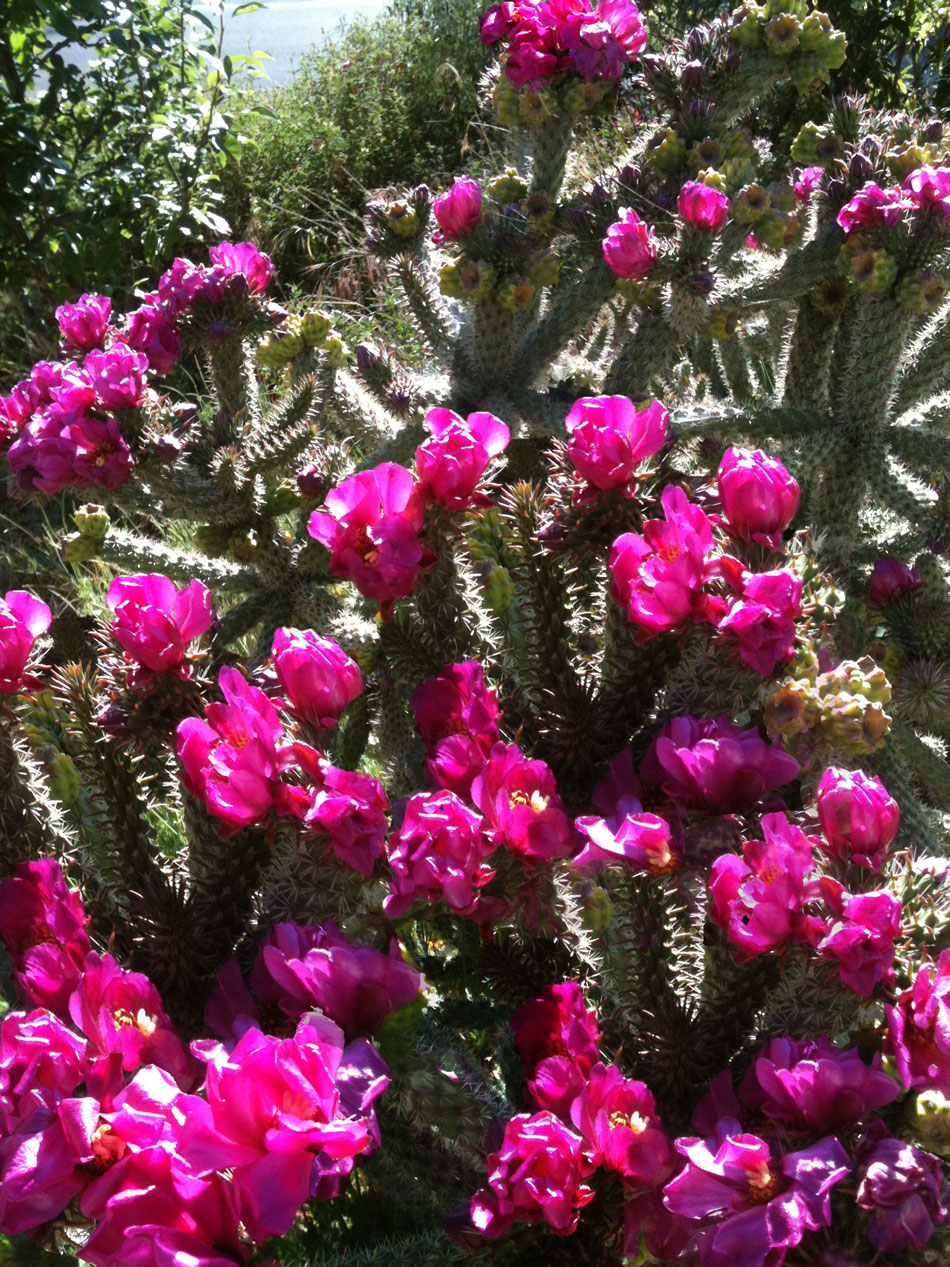 Native to the American Southwest, Tree Cholla (pronounced Cho-Yah) , is a robust, cold-hardy cactus that finds itself at home in environments ranging from the arid Chihuahuan Desert of New Mexico and Texas to Colorado mountains of up to 7000'in elevation. Imposing to say the least, the architechtural, spine-covered cactus seems to want us to believe it is nothing but tough, until the vivid magenta blossoms, a boon to bees and other pollinators, emerge in late spring. Their crepe paper fragility and fleeting beauty reminds us that even tough guys need some lovin'sometimes. Just don't be tempted, no matter how beautiful it may be, to hug this one. The fine spines, arranged in quilting pattern rows (likened by some to chainlink fencing), will keep your admiration at a distance. Just like others of its kin, this true cactus has adapted its leaves for droughty environments full of thirsty predators after its stored water.
Well adapted to arid places, Tree Cholla is drought tolerant to a fault, needing no irrigation other than natural rainfall. And while drought tolerance is not unusual for the members of the family cactaceae, Tree Cholla also tolerates winter moisture and humidity, either of which can be the bane of cold hardy cacti. Shrubby by nature,its candelabra like arms reach 5-8 feet in height supported on a central "trunk". Also known as Walking Stick, or Cane, Cactus, the hollow woody stems, once de-spined, naturally,are sometimes used to create striking walking sticks that highlight the geometrically arranged series of holes running their length.
An eyecatching feature of the xeric garden, do be sure to plant Tree Cholla where it will be backlit by the sun either at day's start or end. Lit in this manner, the spines light up with sunshine, seeming to give the entire plant a halo. Lovely planted with tall grasses, which are also at their finest when backlit.
Laughs at summer heat and completely winter hardy in USDA zones 4-11.
Native to the American Southwest, Tree Cholla (pronounced Cho-Yah) , is a robust, cold-hardy cactus that finds itself at home in environments ranging from the arid Chihuahuan Desert of New Mexico and Texas to Colorado mountains of up to 7000'in elevation. Imposing to say the least, the architechtural, spine-covered cactus seems to want us to believe it is nothing but tough, until the vivid magenta blossoms, a boon to bees and other pollinators, emerge in late spring. Their crepe paper fragility and fleeting beauty reminds us that even tough guys need some lovin'sometimes. Just don't be tempted, no matter how beautiful it may be, to hug this one. The fine spines, arranged in quilting pattern rows (likened by some to chainlink fencing), will keep your admiration at a distance. Just like others of its kin, this true cactus has adapted its leaves for droughty environments full of thirsty predators after its stored water.
Well adapted to arid places, Tree Cholla is drought tolerant to a fault, needing no irrigation other than natural rainfall. And while drought tolerance is not unusual for the members of the family cactaceae, Tree Cholla also tolerates winter moisture and humidity, either of which can be the bane of cold hardy cacti. Shrubby by nature,its candelabra like arms reach 5-8 feet in height supported on a central "trunk". Also known as Walking Stick, or Cane, Cactus, the hollow woody stems, once de-spined, naturally,are sometimes used to create striking walking sticks that highlight the geometrically arranged series of holes running their length.
An eyecatching feature of the xeric garden, do be sure to plant Tree Cholla where it will be backlit by the sun either at day's start or end. Lit in this manner, the spines light up with sunshine, seeming to give the entire plant a halo. Lovely planted with tall grasses, which are also at their finest when backlit.
Laughs at summer heat and completely winter hardy in USDA zones 4-11.
|



